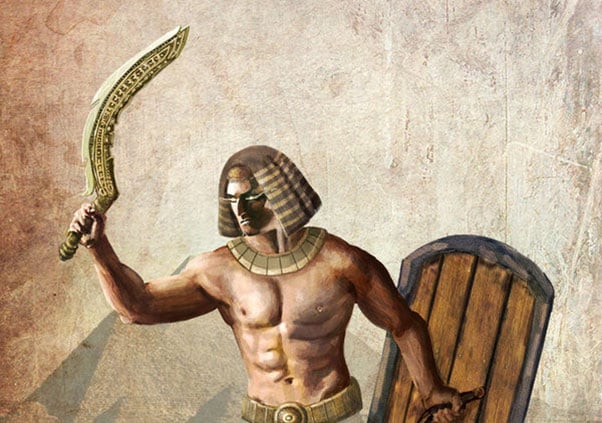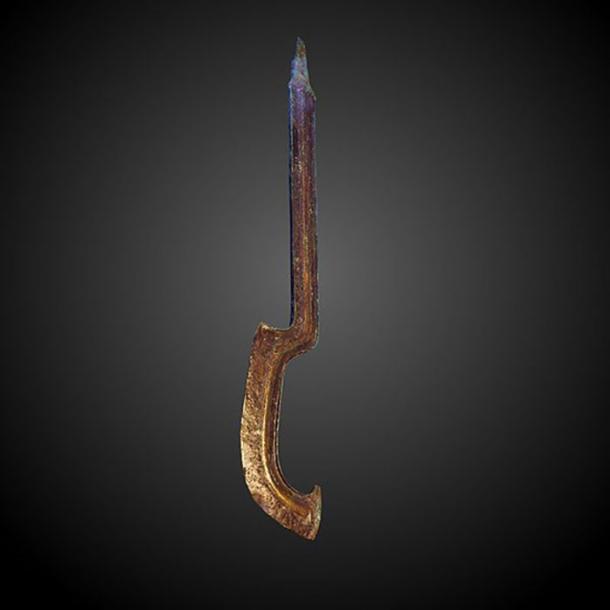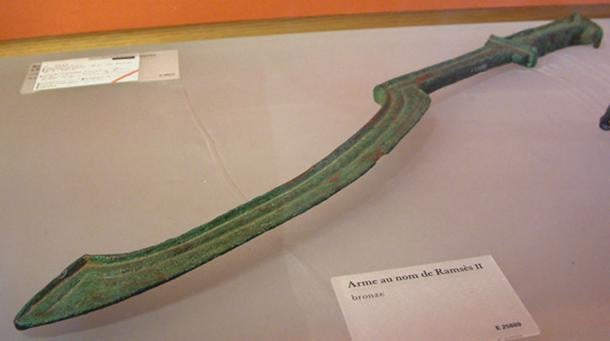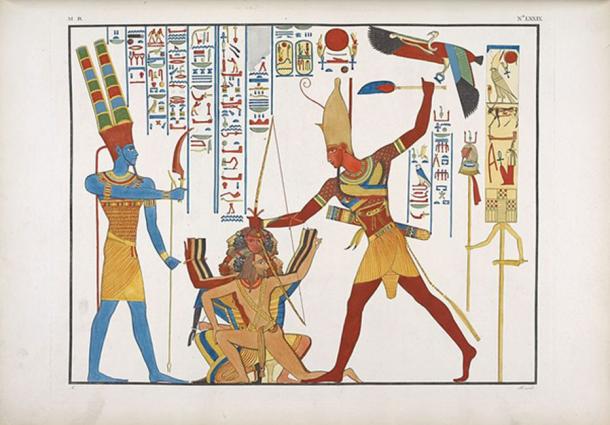Khopesh—The Egyptian Sword that Forged an Empire
Ancient Egypt has been very important in shaping modern Western civilization. For centuries, Egypt has occupied a place in the Western imagination as a mysterious land full of ancient wisdom, hidden secrets, and forgotten empires. Egyptian military technology is no exception. The khopesh, a curved sword commonly used in Egypt during the Bronze Age, represents the oldest sword style used in North Africa and the Near East. It is also with this sword that the Egyptians forged an ancient empire.

Egyptian warrior with a khopesh sword. (MedievalWeaponsBliss)
Defining a Khopesh
A khopesh is defined by a curved blade where the cutting edge of the blade is usually on the blade’s convex edge. The khopesh has a sickle-like shape so that the part of the blade opposite the handle has a slight hook. That’s why some scholars classify the khopesh as a sickle-sword, a type of sword found across the Nile valley, east Africa, the Middle East, and the Indian subcontinent.

A Middle Bronze Age khopesh. (Rama/CC BY SA 2.0)
Origins of the Khopesh and its Early History
The khopesh is closely associated with Egypt, but it did not originate there. The earliest forms of the khopesh were invented in Mesopotamia by the beginning of the 2nd millennium BC. Furthermore, the Stele of the Vultures, dating to 2500 BC, depicts the Sumerian king, Eanatum of Lagash, wielding what appears to be a sickle-shaped sword. This weapon could be a precursor to the khopesh.
- Weapons Control in Ancient Greece: When an Accident was Deadly
- The Supernatural Weapons of the Mahabharata and Their World Destroying Power
- 10 Innovative Medieval Weapons: You Would Not Want To Be At The Sharp End Of These!
After being developed in Mesopotamia, the khopesh was introduced to Syria and the Canaanite city-states. It arrived in Egypt from Mesopotamia sometime after 1550 BC, during the New Kingdom period.
The earliest metal weapons were copper axes. Before the Bronze Age, only axes were available because copper is not strong enough to withstand the metallurgical processes required to make swords. After the use of bronze became more common, however, the stronger metal allowed for greater force of impact. Blades long enough to be swords could now be made. Over the centuries, this led to the development of the khopesh.

An ancient Egyptian khopesh sword. (Guillaume Blanchard/CC BY SA 3.0)
Uses of the Khopesh
Unlike the axe and the spear which had civilian uses before they were weapons of war, the sword was probably one of the first weapons designed exclusively for battle. As a curved sword, the khopesh was used primarily as a cutting, slashing, and chopping weapon. This was useful before the use of body armor designed to withstand slashing became widespread.
In addition to slashing and chopping, the khopesh could also be used for thrusting. This would have made it useful against armored opponents. The hook on the far end of the weapon could also be used to rip away an opponent’s shield. The multiple uses of the khopesh would have made it a feared and versatile weapon. The khopesh may have also been a prestige weapon similar to the role of the mace in Egyptian art.

Wielding a khopesh to smite enemies in Egyptian art. (Public Domain)
Influence of the Egyptian Khopesh Sword on Other Cultures
Beginning around the 6th century BC, the Greeks began to use a curved bladed weapon which they called the machaira or kopis. Some scholars suggest the name kopis may have been derived from the Egyptian word khopesh. Additionally, the Hittites, the sworn rivals of the Egyptians during the Bronze Age, also used swords similar in design to the khopesh. However, it is unclear whether they copied the Egyptian design or inherited the khopesh directly from Mesopotamia.
Curved swords similar to the khopesh are also found in east and central Africa. Cultures in the region containing modern Rwanda and Burundi used what appear to be sickle-like daggers comparable to the khopesh. It is unclear whether these blade making traditions were inherited from Egypt or if the dagger design was developed independently that far south of Mesopotamia.
- A Flexible and Deadly Blade: The Dangerous Urumi
- Unknown Weapons of the Samurai: The Forgotten Warrior Arsenal from Feudal Japan
- Ten Diabolical Weapons and Strategies of War from the Ancient World
A khopesh-like sword or dagger is also found in Dravidian cultures in southern India as well as in parts of non-Dravidic Nepal in the north. The presence of khopesh-like swords among Dravidian cultures is interesting in light of the link between the Dravidians and Mesopotamia. The Indus Valley, or Harappan civilization, known for its trade with Mesopotamia as early as 3000 BC was probably Dravidian by ethnicity. The pre-Aryan Indus Valley civilization also lasted in one form or another until the mid-2nd millennium BC. This is the right era for transmission of khopesh-like blade making traditions to the Dravidian civilization from Mesopotamia.
The Khopesh and Egyptian Military Supremacy During the Bronze Age
During the Bronze Age, the Egyptians were a world power within their domain. Egypt remained a powerful state through the Bronze Age. The Egyptians, for example, were able to successfully repel the sea peoples yet other regions such as Canaan were less successful. It is possible that one of the reasons the Egyptian Empire was so successful in preserving its sovereignty was because of an advanced military with effective weapons such as the khopesh. Use of the khopesh by itself would not have been enough, but it probably helped.

A limestone ostracon depicting Ramesses IV smiting his enemies, from the 20th dynasty, circa 1156-1150 BC. (JMCC1/CC BY SA 2.5)
Top Image: Khopesh Design. Source: A-WingMaster/Deviant Art
By Caleb Strom
References
Elliott, Paul. 2017. Warfare in New Kingdom Egypt. Fonthill Media.
Freewalt J, and L. Ciraolo. 2014. ANCIENT MILITARY TECHNOLOGY AND MATERIEL: CONTINUITY AND CHANGE IN ANCIENT CLOSE-COMBAT WARFARE. American Military University.
Gordon, D. H. 1958. 14. Scimitars, Sabres and Falchions. Man: Journal of the Royal Anthropological Institute of Britain and Ireland.
K.L. 2018. Who Were the Sea People? Available at: https://www.thoughtco.com/who-were-the-sea-people-119065
Lenk-Chevitch, P. 1941. 60. Note Concerning the Distribution of the Sickle-Sword. Man: Journal of Royal Anthropological Institute of Britain and Ireland
Sapiro, David, and Bryan Webler. 2016. "Fabrication of a Bronze Age Sword using Ancient Techniques." JOM
Swanson, E. N.D. Harappan Civilization. Available at: http://www.thenagain.info/WebChron/India/Harappa.html
Wade, K. 2017. The sword and the knife: a comparison of Ancient Egyptian treatment of sword injuries and present day knife trauma. Res Medica: Journal of the Royal Medical Society
Whipps, H. 2008. How Ancient Trade Changed the World Available at: https://www.livescience.com/4823-ancient-trade-changed-world.html
Winters, Clyde Ahmad. 1990. The Dravido-Harappan Colonization of Central Asia. Central Asiatic Journal




















Comments
You stated “Before the Bronze Age, only axes were available because copper is not strong enough to withstand the metallurgical processes required to make swords.” I’ve read that there were copper swords but they were very short due to the weakness you describe. I read you references and did not find this statement. Where did you get this information. Or is it just a supposition?
The cutting edge of the khopesh is on the convex side of the sword. If it were on the concave side, as stated, it would be a sickle.